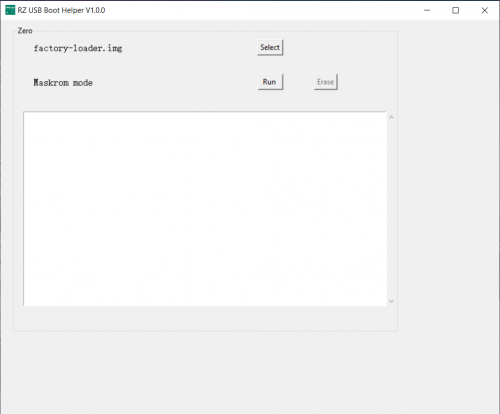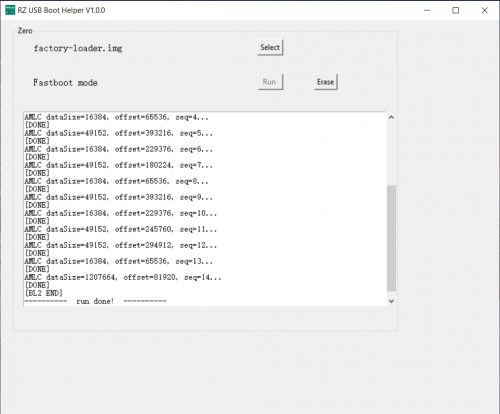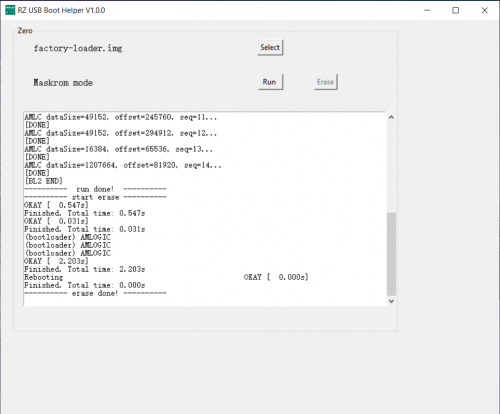Zero/install/eMMC erase
Radxa Zero > Installation > Erase eMMC
How to completely erase the Radxa Zero eMMC
This guide describes how to completely erase Radxa Zero eMMC. Since we are running different image, Android or multiple Linux distribution on the Zero, these images uses different bootloader version or boot sequence. It's better to erase the eMMC completely and leave a clean environment before installing new images to eMMC.
Requirement
- Radxa Zero
- USB A to C cable
- A PC/laptop running Windows, Linux/macOS.
Windows
Step 1: Install drivers
Download Zagdig, install it and choose libusb-win32, then click Install Driver.
Download the Android driver from Google:
Click here to download the Google USB Driver ZIP file (ZIP)
Unzip it and right click the .inf file to install the driver.
Step 2: Use RZ USB helper
RZ USB helper is a tool by Radxa for Windows users to manage Radxa Zero booting easier. Download it from Radxa DL.
Press and hold the USB boot button on the Zero, plug in the USB to PC, Maskrom mode should be detected.
Select the loader in the RZ_USB_Boot_Helper zip and click Run.
Click Erase to erase the eMMC completely.
Linux
For Linux, we use amlogic boot tool to download the bootloader and boot the Zero into the USB Disk mode to export the eMMC to host PC as a USB Disk, then we can use dd or other tools to write images to the USB Disk(eMMC).
Step 1: Install pyamlboot tool
sudo apt install pip3 sudo pip3 install pyamlboot
Step 2: Erase Android if installed(optional)
If you have Android installed on Zero before, we suggest to wipe it. Check Erase eMMC page. If you have installed Linux or other distribution already, you can skip this step.
Step 3: Boot into USB Disk mode
Press and hold the USB boot button on Zero, plug in it to PC, lsusb should see the following:
Bus 002 Device 030: ID 1b8e:c003 Amlogic, Inc. GX-CHIP
Download the USB disk loader and run it on Zero
wget https://dl.radxa.com/zero/images/loader/rz-udisk-loader.bin boot-g12.py rz-fastboot-loader.bin
It should output:
Firmware Version : ROM: 3.2 Stage: 0.0 Need Password: 0 Password OK: 1 Writing rz-fastboot-loader.bin at 0xfffa0000... [DONE] Running at 0xfffa0000... [DONE] AMLC dataSize=16384, offset=65536, seq=0... [DONE] AMLC dataSize=49152, offset=393216, seq=1... [DONE] AMLC dataSize=16384, offset=229376, seq=2... [DONE] AMLC dataSize=49152, offset=245760, seq=3... [DONE] AMLC dataSize=49152, offset=294912, seq=4... [DONE] AMLC dataSize=16384, offset=65536, seq=5... [DONE] AMLC dataSize=1406320, offset=81920, seq=6... [DONE] [BL2 END]
Now lsusb should show the following device:
Bus 002 Device 013: ID 1b8e:2200 Amlogic, Inc. USB download gadget Serial: AMLG12A-RADXA-ZERO
The Zero is in USB disk mode now, your PC should popup a new USB drive.
Step 4: Write image to eMMC
You can use dd to write the Linux image to the eMMC of Zero now.
sudo dd if=/path/to/image of=/dev/sdx bs=1M sync
Carefully Eject the Zero USB drive and unplug and plug the power, Zero should boot the new image now.





